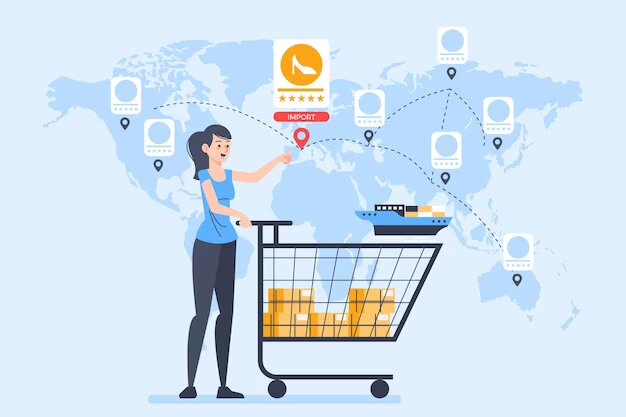Now Reading: D2R:The beginning of a new era in retailing
-
01
D2R:The beginning of a new era in retailing
D2R:The beginning of a new era in retailing

Let me introduce you to the beginning of a new world in retailing which is D2R. Updating with changes in the circumstances is one of the essential point of each and every business. To ace the profitability, retail brands keep on discovering some new and unique ways to connect with the customers. The pandemic period had seen the rise of D2C (direct to consumer) which entails one-on-one relationship with consumers, which was based on online marketing. But, the fact that more than 85% of purchases are still predominantly made through wholesalers, has brought the D2C model at stake, as obtaining data and insights about in-store purchases is quite a big task.
Then, there is emergence of a new model or you can say an approach called D2R(direct to retailing) which entails brands with some benefits like, it aids to measure marketing impact and how it’s driving in-store wholesale sales while maintaining a one-to-one relationship with their customers no matter where they shop.

“D2R” and “D2C” are abbreviations that represent different distribution strategies in the business world. While they both involve direct interactions between manufacturers or producers and end customers, they have distinct approaches and implications. In order to know deeply about D2R and D2C, let us know the difference between the two:
Key Differences:
- Target Customer: D2R targets retailers as customers, while D2C targets individual consumers.
- Brand Visibility: D2R might have lower brand visibility to end consumers, whereas D2C offers direct brand-to-consumer engagement.
- Pricing Control: D2R has less control over retail pricing, while D2C allows manufacturers to set their own prices.
- Distribution Focus: D2R focuses on efficient distribution to retailers, while D2C focuses on individual shipping to consumers.
- Relationships: D2R emphasizes relationships with retailers, while D2C emphasizes building strong connections with individual consumers.
In summary, D2R involves selling products directly to retailers, while D2C involves selling products directly to end consumers. Both strategies have distinct advantages and considerations, and businesses often choose the one that aligns with their product, target audience, and overall goals.

The direct-to-retail strategy( D2R) is a distribution approach in which manufacturers or producers sell their products directly to retailers, bypassing traditional intermediaries such as wholesalers, distributors, or middlemen. This strategy allows manufacturers to establish a direct relationship with retailers, which can lead to various benefits for both parties. Here’s a closer look at the direct-to-retail strategy:
Here are some of the key Characteristics of D2R:
- Cutting Out Intermediaries: In a traditional distribution model, products pass through multiple intermediaries before reaching the end retailer. The direct-to-retail strategy eliminates these intermediaries, streamlining the supply chain and reducing associated costs.
- Direct Manufacturer-Retailer Relationship: Manufacturers engage directly with retailers, negotiating terms, pricing, and supply agreements. This direct relationship enhances communication and collaboration between the two parties.
- Control over Branding and Marketing: Manufacturers have more control over how their products are presented and marketed to consumers. This control extends to branding, packaging, and promotional strategies.
- Efficient Inventory Management: Manufacturers can have better visibility into retailers’ inventory levels and demand patterns. This can lead to more accurate production planning and reduced overstock or stockouts.
- Customized Offerings: Manufacturers can tailor their offerings to meet the specific needs of retailers, creating a more personalized product assortment that aligns with the retailer’s target market.
Let us examine its benefits:
- Improved Margins: By eliminating intermediary markups, manufacturers can often achieve higher profit margins. Retailers may also benefit from reduced costs, allowing both parties to retain a larger share of the revenue.
- Faster Market Entry: Direct-to-retail allows manufacturers to quickly bring products to market without the delays associated with intermediaries. This agility is particularly valuable for time-sensitive products or emerging trends.
- Stronger Brand Relationship: Direct interaction with retailers fosters a deeper understanding of market trends and consumer preferences. This helps manufacturers tailor their products to meet retailer and consumer demands effectively.
- Reduced Distribution Costs: Since the distribution chain is shortened, costs related to warehousing, transportation, and logistics can be minimized, resulting in cost savings for both manufacturers and retailers.
- Enhanced Control: Manufacturers have greater control over how their products are presented, priced, and positioned on retailers’ shelves, ensuring brand consistency and alignment with their overall strategy.
Taking a look at the Challenges of D2R method:
- Logistical Complexity: Manufacturers may need to invest in establishing efficient logistics systems to handle direct-to-retail distribution, which can be challenging and costly.
- Risk of Channel Conflict: Manufacturers must carefully manage relationships with existing distributors or intermediaries to avoid conflicts that could harm these relationships.
- Retailer Resistance: Some retailers may prefer to work with established distributors due to existing relationships and ease of operations.
- Resource Intensity: Manufacturers need the resources to manage direct relationships with multiple retailers, including negotiations, supply agreements, and ongoing support.
Industries Using Direct-to-Retail Strategy:
The direct-to-retail strategy is particularly common in industries where manufacturers have strong brand recognition, innovative products, or the ability to offer unique value propositions. Consumer electronics, fashion, beauty products, and specialty foods are examples of industries where this strategy is often employed.

In conclusion, the direct-to-retail strategy offers manufacturers a way to forge stronger relationships with retailers, gain more control over branding and distribution, and potentially achieve better profit margins. While it comes with logistical challenges and considerations, it can be a strategic approach for businesses looking to streamline their distribution and enhance their market presence.
Its true that business requires managing of multiple risks and decision making, and therefore, retail brands often come up with new innovative methods to reach out to their customers. So, its best to recognize as to which method work out best for your brand and work on it. This particular article examined many aspects of both the methods( D2R and D2C), inquiring about not only its benefits, but also the challenges it incurs.











